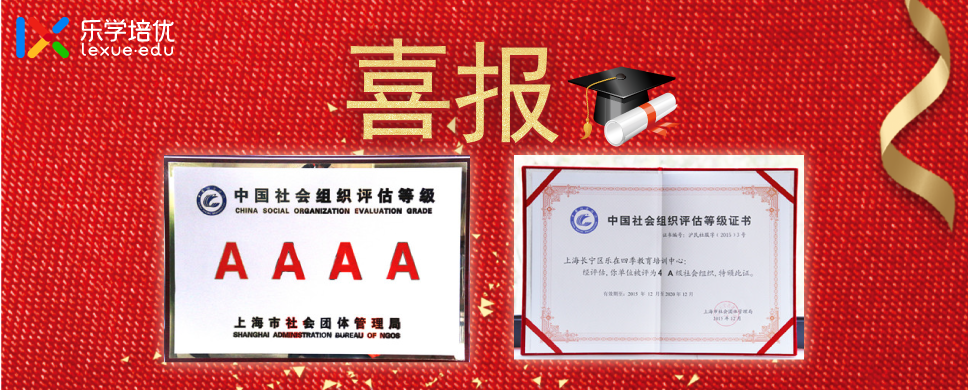
免费预约试听

重估音标的价值:为什么那些年掌握音标知识的孩子都成功了
前言
学习音标不仅可以帮助我们的孩子掌握更准确的发音,还可以加深学生们对于英语语法的理解,从而进一步助推校内测验及升学测试英语学科成绩。在这里,乐在四季英语部的老师根据多年教授SBS以及新概念的经验,结合最近的初中择校英语学科考察内容,将英语语法中需要使用到的音标知识从头到尾细致地整理了一番,读完以后,你将会明白有时候孩子英语成绩提升碰到了瓶颈有可能真的和缺乏针对性的音标训练息息相关。

考点一:冠词a和an的用法区别
考察音标知识:什么是元音,什么是辅音,什么是元音字母,什么是辅音字母,元音与元音字母的区别,辅音与辅音字母的区别。
不定冠词有a和an两种形式,a用于辅音(注意不是辅音字母)开头的可数名词前,an用于元音(注意不是元音字母)开头的可数名词前。
例如:
a boy,a man,a monkey,a university,a European country
an apple, anegg, an elephant, an old woman, an hour, an honor, an island, an umbrella
例题
1. I earn 10dollars ______ hour as ______ supermarket cashier on Saturdays.
A. a; an B. the; a C. an; a D. an; the
2. At thattime Tom was _____ one-year-old baby.
A. a B. an C. the D. /
3. ______useful book it is!
A. Whatan B. How a C. What a D. What
4. Oneafternoon he found _____ handbag. There was ____"s" on the corner of_____ handbag.
A. a; an;the B. a; a; the C. an; an; an D. the; a; a

考点二:可数名词单数变复数
考察音标知识:可数名词单数变复数规则变化下,结尾s的发音;尤其需要注意以元音字母+y与及辅音字母+y结尾的可数名词单数变复数时的区别,前者是该词尾直接加s,后者是将y改为i再加-es。
英语可数名词单数变复数主要有以下规则,请注意结尾s的发音
一、绝大多数的可数名词的复数形式,是在该词末尾加上后辍-s。读音变化:结尾是清辅音读[s],结尾是浊辅音或元音读[z]。例:friend→friends; cat→cats; style→styles; sport→sports; piece→pieces
二、凡是以s、z、x、ch、sh结尾的词,在该词末尾加上后辍-es构成复数。读音变化:统一加读[iz]。例:bus→buses; quiz→quizzes; fox→foxes; match→matches; flash→flashes box →boxes; watch →watches;actress →actresses; class →classes; coach(长途车)→coaches; dress→dresses; sandwich →sandwiches;toothbrush →toothbrushes; waitress(女侍者)→waitresses
三、以辅音字母+y结尾的名词,将y改变为i,再加-es。读音变化:加读[z]。例:candy→candies; daisy(雏菊)→daisies; fairy→fairies; lady→ladies; story→stories strawberry →strawberries;baby →babies; puppy →puppies; library →libraries;dictionary →dictionaries; cherry →cherries; activity →activities
四、以-o结尾的名词,如果不是外来词或缩写,就加-es,否则加-s构成复数。(有生命的加es,无生命的加s)读音变化:加读[z]。例:tomato→tomatoes; potato→potatoes;torpedo(鱼雷)→torpedoes; bingo(彩票式游戏)→bingoes 反例:silo(青贮塔)→silos; piano→pianos(外来词); photo→photos; macro(宏指令,计机算语言)→macros(缩写词)
五、以-f或-fe结尾的名词,多为将-f或-fe改变为-ves,但有例外。读音变化:尾音[f]改读[vz]。例:knife→knives; life→lives; leaf→leaves; staff(员工)→staves; scarf(围巾)→scarves 目前搜集的直接加s:roof-roofs,belief-beliefs,gulf(海湾)-gulfs, serf(农奴)-serfs,safe-safes,chief(负责人)-chiefs 这几个可变可不变:scarf-scarfs,handkerchief-handkerchiefs
例题
1. At nightthe koala bear gets up and eats _____.
A. leaf B. leaves C. leafs
2. The _____meeting room is near the reading room.
A.teacher B. teacher's C. teachers' D. teachers
3. Lucy willshow us some new ___ of hers.
A. photo B. photos C. photoes
4. In Britain____ are all painted red.
A. letterboxes B. letters boxes C. letter box D. letters box


考点三:动词的第三人称单数
考察音标知识:动词原形变第三人称单数的发音规律。
动词原形变第三人称单数的规则与发音规律同名词单数变复数大致相同,请认真观察。
1、大多数动词在词尾加“S”在清辅音后发音为[s],在浊辅音及元音后发音为[z]。如:
①stop-stops [s] ; make-makes [s]
②read-reads [z] ;play-plays [z]
2、以辅音字母加“y”结尾的,要先将“y”变为“i”,然后在加“es”读[iz] 如:
fly-flies [z];carry-carries [z]
study-studies [z]; worry-worries
3、以“s, x, ch, sh”结尾的,在词尾加“es”,发音为[iz] 如:
teach-teaches [iz]; watch-watches [iz]
4、以“o”结尾的动词,加“es”,读[z] 如:
go-goes [z] do-does [z]
下面几个动词变为单数时,原词的元音部分的发音发生了较大的变化,请注意记忆。如:
1、do [du:]-does [dz]
2、say [sei]-says [sez]
以不发音字母“e”结尾的开音节词,如果尾音是[s],[z]时,加“s”后字母“e”发音,与所加“s”
一起读做[iz]。如:close-closes [iz]
例题
1. A nurseusually ____ a white uniform.
A. wear B. wearing C. wears D. to wear
2. Theelephant likes ____ her friends and ____ grass.
A. play with;eat B. play with; eats C. to play with; eat D. to play with; eats
3. Mr. Yang_____ English this term.
A. teachesour B. teaches us C. teachs us D. teach our
4. How _____Mr. Brown ____ to America?
A. do; go B. is; go C. does; go D. does; goes

考点四:动词的ing形式
考察音标知识:什么是开音节;什么是闭音节;什么是重读。
1.一般在词尾加-ing.go---going
2.以不发音的字母e结尾时,先去e,再加-ing.make---making
3.以重读闭音节结尾,且词尾只有一个辅音字母时,先双写这个辅音字母,再加-ing.run---running
4.以-ie结尾的单词,一般要把-ie改成-y,再加-ing.lie---lying
例题
1. Mary isn'there at the moment. She ___ later.
A. comes B. came C. has come D. is coming
2. -May Ispeak to Mr. Morgan? -Sorry. He ___ onthe farm.
A. works B. worked C. is working D. has worked
3. Thepopulation of the world ___ still _____ now.
A. will;grow B. has; grown C. is; growing D. is; grown
4. -What'sthat noise? -Oh, I forgot to tell you.The neighbors ____ for a party.
A. prepare B.are preparing C. will prepare D. have prepared


考点五:动词的过去式
考察音标知识:什么是重读闭音节。规则动词过去式的读音规律有哪些。尤其需要注意以元音字母+y结尾的动词和以辅音字母+y结尾的动词在过去式变化上的不同,前者在动词原形后直接加ed,后者动词变y为i再加ed.
①一般情况下在动词原形后直接加-ed。如:wanted,played。
②以不发音的字母e结尾的动词,去掉e再加-ed。如:hoped,lived。
③重读闭音节单词需双写最后一个辅音字母再加-ed。如:stopped。
④以辅音字母+y结尾的动词变y为i,再加-ed。如:studied,worried。
规则动词过去式的读音也有规律可循。
请记住:清后[t],元浊[d],[t] [d]之后读[Id]。
①清辅音[p] [k] [f] [s] [F] [tF]等后,ed要读[t]。如:worked,finished。
②元音或浊辅音[b] [g] [v] [z] [m]等后,ed要读[d]。如:lived,called。
③[t]或[d]后,ed读[Id]。如:started,needed。
例题
1. She livedthere before he ___ to China.
A. came B. comes C. come D. coming
2. I ____ but___ nothing.
A. waslistened; was hearing B. listened;heard C. have listened; heard D.listened; heard of
3. When didyou _____ here?
A. got to B. reached C. arrive in D. reach
4. Tom was socareless that he ___ his right arm when he was riding to school.
A. hurts B. hurt C. has hurt D. had hurt

考点六:形容词和副词的比较级和最高级
考察音标知识:什么是单音节;什么是双音节;什么是多音节;如何区分单音节、双音节和多音节。
1.一般单音节词和少数以-er,-ow结尾的双音节词,比较级在后面加-er,最高级在后面加-est;
(1)单音节词
如:small→smaller→smallest short→shorter→shortest
tall→taller→tallest great→greater→greatest
(2)双音节词
如:clever→cleverer→cleverest narrow→narrower→narrowest
2.以不发音e结尾的单音节词,比较在原级后加-r,最高级在原级后加-st;
如:large→larger→largest nice→nicer→nicest able→abler→ablest
3.在重读闭音节(即:辅音+元音+辅音)中,先双写末尾的辅音字母,比较级加-er,最高级加-est;
如:big→bigger→biggest hot→hotter→hottest fat→fatter→fattest
4.以“辅音字母+y”结尾的双音节词,把y改为i,比较级加-er,最高级加-est;
如:easy→easier→easiest heavy→heavier→heaviest
busy→busier→busiest happy→happier→happiest
5.其他双音节词和多音节词,比较级在前面加more,最高级在前面加most;
如:beautiful→more beautiful→most beautiful
different→more different→most different
easily→more easily→most easily
注意:
(1)形容词最高级前通常必须用定冠词the,副词最高级前可不用.
例句:The Sahara is the biggest desert in the world.
(2)形容词most前面没有the,不表示最高级的含义,只表示"非常".
It is a mostimportant problem.
=It is a veryimportant problem.
6.有少数形容词、副词的比较级和最高级是不规则的,必须熟记.
如:good→better→best well→better→best
bad→worse→worst ill→worse→worst
old→older/elder→oldest/eldest
many/much→more→most little→less→least
far →further/farther→furthest/farthest
例题
1. Your roomis _____ mine.
A. twice as largethan B. twice the size of C. bigger twice than D. as twice large as
2. At last hebegan to cry ____.
A. hard andhard B. more hard and more hard C. harder and harder D. less hard and less hard
3. _____ youcome back, ____ it will be.
A. Thequicker; the best B. The sooner; thebetter C. Faster; the better D. The sooner; better
4. The GreatPyramid is about 137 meters high today, but it was once ____.
A. higher B. highest C. high too D. more high

【返回】
名师推荐







